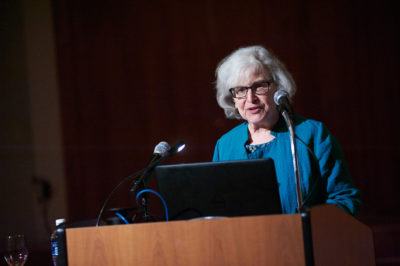In 1942, Czechoslovakian dress designer Hedwig Strnad and her husband died in the Holocaust. According to Hasia Diner, a professor of Hebrew and Judaic Studies and History at New York University, Strnad was emblematic of the nine million Jews living in Europe at the start of the war. Diner’s talk at FIT on April 21, “What the World Lost: the Holocaust and the Destruction of European Jewry,” was intended partly as a corrective: The Jews who perished, she said, have often been depicted as “old-world, shtetl” Jews; in fact, the six million victims covered a broad spectrum, from Orthodox who spent their days studying the Talmud, to readers of Marx and followers of Stalin, to filmmakers and other artists. Strnad’s family, Diner said, was typical of many Jews who, beginning in the 19th century, had moved into urban areas and embraced modernity.
“The rise of commercial capitalism,” she said, “meant that individual creativity, not religion, was emphasized.” For individuals as diverse as Marc Chagall, Sigmund Freud, and Marcel Proust, “their work trumped their Jewishness, though they found ways to incorporate it into their work.” Though little is known about Strnad, her design sketches depict women wearing their skirt hemlines at or above the knee, their heads at a cocky angle. “They went out ready to meet the world head on,” Diner observed.
Through a brother living in the United States, Strnad and her husband applied for visas to escape Europe. Strnad submitted sketches as a way to demonstrate financial independence. Tragically, the visas were not granted, and the Strnads died in part because of U.S. bureaucracy. In 2013, for a show at the Jewish Museum Milwaukee, Strnad’s sketches were made into actual garments, a process that took 12 people nearly 3,000 hours. Reproductions of the drawings were displayed in the Dubinsky Center lobby as part of FIT’s Holocaust commemoration events, which also included Diner’s talk and a public reading from the list of names of the murdered. The event was presented by the committee and the FIT Diversity Council.

